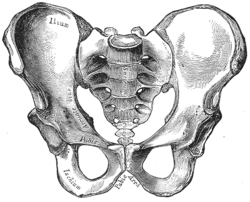Pelvic surface of sacrum
| Sacrum | |
|---|---|

Sacrum, pelvic surface
|
|

Image of a male pelvis (sacrum is in center)
|
|
| Details | |
| Identifiers | |
| Latin | Os sacrum |
| MeSH | D012447 |
| TA | A02.2.05.001 |
| FMA | 16202 |
|
Anatomical terms of bone
[]
|
|
The sacrum (/ˈsækrəm/ or /ˈseɪkrəm/; plural: sacra or sacrums;) in human anatomy is a large, triangular bone at the base of the spine, that forms by the fusing of sacral vertebrae S1–S5 between 18 and 30 years of age.
The sacrum is situated at the upper, back part of the pelvic cavity, between the two wings of the pelvis. It forms joints with four other bones. The two projections at the sides of the sacrum are called the alae (wings), and articulate with the ilium at the L-shaped sacroiliac joints. The upper part of the sacrum connects with the last lumbar vertebra, and its lower part with the coccyx (tailbone) via the sacral and coccygeal cornua.
The sacrum has three different surfaces which are shaped to accommodate surrounding pelvic structures. Overall it is (curved upon itself). The base of the sacrum, the broadest and uppermost part, is tilted forward as the sacral promontory internally. The central part is curved outward toward the posterior, allowing greater room for the pelvic cavity.
...
Wikipedia
